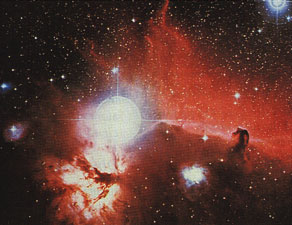Physics 162H Honors Project: Nebulae
 Nebulae are clouds of interstellar dust and gas which are back-lighted by stars behind and within them. The photons from these stars are scattered through the clouds, illuminating them. Most of the light appearing to come from a nebula is reflected and refracted light rather than light it generates itself.
Nebulae are clouds of interstellar dust and gas which are back-lighted by stars behind and within them. The photons from these stars are scattered through the clouds, illuminating them. Most of the light appearing to come from a nebula is reflected and refracted light rather than light it generates itself.
This does not mean that the nebulae are dark in and of their own right. They have temperatures associated with them, and that means they will be visible in some range of the electromagnetic spectrum. Some, such as the shock-front of a ring nebulae, can exceed temperatures of 6000K and are visible in the X-ray spectrum. In the case of nebulae, temperature is a measure of the average kinetic energy of the molecules in a given area of space rather than the ideas of warm and cold familiar to you (though they are related).
The nebulae you will observe are known as emission nebulae. Typically, there will be a new O or B type star producing large amounts of light embedded in such nebulae. The reddish hue of the nebulae is due to the emission by the hydrogen atoms in the nebulae in the red part of the spectrum. Such emission nebulae are refered to as HII regions.
There are usually a wide array of nebulae visible throughout the year in the sky. Photography of the nebulae is easy with the CCD camera, as its sensitivity will pick up even very faint nebulae. When you view a nebula through the telescope, you will not see the red indicative of the hydrogen emission. This is because your eyes are easily fooled by the barrage of incoming light, and the nebula will appear an off-green to the naked eye. Film, however, is not fooled, and will capture the predominant colors of the nebula more readily. Check with the observatory manager to be sure a certain nebula is visible, and whether the CCD or a conventional camera would be more efficient.
Procedure
- Devise a plan of attack. Consult with the manager and choose the nebula you wish to try to view through the telescope. Messier objects are the most likely to be found, so it is strongly recommended that you stick to the Messier Catalog. It is also recommended that you choose objects visible in the Northern hemisphere. Find coordinates for your desired nebula.
- Locate a nebula in the telescope at Davis Hall.
- With the manager's assistance, attach either a camera or the CCD to the scope. An option for a very faint nebula is to observe it visually and attempt to sketch a picture. Most of the nebulae visible from DeKalb will probably require CCD shots due to the light pollution and photographic difficulty.
- Capture at least one image, or more if you choose. Try several different images in different scopes and powers of magnification.
- With use of photography, or with the CCD images, the pictures may be enlarged so that they may be more visible. The important part is to be able to distinguish the nebula from the background.
Nebulae Interpretation
Most intensive analysis of nebulae is conducted with the intent of locating the remnants of the supernovae which caused then, or to locate dense molecular clouds from which new stars are born. Both these avenues of research usually require dedication and telescopes that see in non-optical wavelengths, such as X-ray and Radio. With a good photometer and spectrometer, it would be possible to distinguish different compositions of a nebula, but that is a difficulty slightly beyond the scope of a basic honors project. As such, all one needs to do for the write up is to interpret what is seen and classify it as either a ring nebula of a diffuse nebula. For those wishing to focus on nebulae as stellar remnants, then M1 in Taurus is recommended, as the supernova which spawned it has historical documentation readily available.
Observatory Manager
Jeremy Benson
jjbenson@niu.edu
Location
Davis Hall Room 703Normal and Locust Roads
DeKalb, IL 60115Google Maps